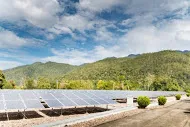
Philippines to get 2 solar plants totalling 41MWp
Find out where these will be located.
Conergy, one of the largest downstream solar companies globally, has recently announced that it will build two new solar plants totalling 41MWp in the Philippines.
According to a release from Conergy, the new projects bring Conergy’s total contracted volume in the fast-growing Asian market to 73 MWp.
The Philippines is rapidly increasing energy generation in order to reduce electricity prices, which are the fifth highest in the world, and to improve the country’s competitiveness ahead of next year’s launch of the ten-country Association of South East Asian Nations (ASEAN) single market, which will be the six biggest in the world.
Electricity market data indicate that average spot electricity prices decline as solar power generation increases, due to reduced consumption of expensive diesel.
Yields from solar panels in the Philippines are roughly equivalent to those in Miami or Cairo. The Philippines government is therefore supporting solar through a feed-in-tariff of 0.21 USD / 0.17 Euros per kWh of grid-connected PV.
Here's more from Conergy:
The new plants will be built on the island of Negros in the Philippines, for San Carlos Solar Energy, Inc. (SaCaSol), a joint venture between European-based investment and advisory firm, ThomasLloyd and Bronzeoak Philippines.
They are scheduled for completion and grid connection in June 2015. Conergy will then provide technical and consultancy services for the plants’ ongoing operation and maintenance together with a local service contractor.
Alexander Lenz, President Conergy Asia & Middle East, said: “We are very encouraged by the increasing recognition of the relevance of solar power in the Philippines as more developers and project sponsors ramp up their investments in utility-scale solar to meet the growing power demand in the country.
These two additional projects with SaCaSol, which triple their solar energy capacity, not only underscore solar’s growing acceptance and strong momentum in the country but also demonstrate the improving economics of solar in the Philippines.”
The first project is called SaCaSol I C/D and involves the expansion of the Philippines’ first large solar plant SaCaSol I A/B, located close to the port of San Carlos City, which was built by Conergy for SaCaSol and opened by President Benigno Simeon Aquino in May.
The capacity of SaCaSol I will be increased by 23MWp to 45MWp – enough to supply 27,300 homes in the local area.
The second project, SaCaSol II A, will be a completely new 18MWp solar power plant close to La Carlota City on Negros’s west coast, which will supply an estimated 26,529 megawatt hours of electricity to the grid annually, enough for 11,000 homes, and avoid 16,200 tons of carbon emissions per year.













 Advertise
Advertise











